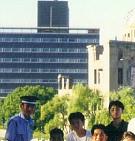



The A-bomb Dome is the ruins of the former Hiroshima Prefectural Industrial Promotion Hall. It is to be preserved as an appeal for world peace and as a witness to the horror of nuclear weapons. The name, A-bomb Dome, grew up among the people of Hiroshima because of the dome-shaped framework left at the top of the central tower.
The background and history of this building are as follows:
Around 1912 the decision was made to build a Hiroshima Prefectural Commercial Exhibition Hall in Sarugaku-choo. It was to be in Secession style, designed and built by the Jan Letzel Construction Company. Jan Letzel was a distinguished Czech architect who designed such buildings as the main hall of Sophia University in Tokyo, the Sanyoo Hotel in Shimonseki and the Miyajima Hotel in Itsukushima.
Construction began in January 1914, and was completed on April 5, 1915. In the exhibition hall, there were products of Hiroshima Prefecture both on permanent exhibition and for sale. After the inauguration of the Hiroshima Prefecture Art Association in 1916, art exhibitions were held every year in this hall. When expositions and country fairs were held at the western drill ground as the main site, the hall was utilized as a second site. For 30 years after its opening, the hall was widely used by the people of Hiroshima. In January 1921 the building’s name was changed to the Hiroshima Prefectural Products Exhibition Hall, and in November 1933 it became the Hiroshima Prefectural Industrial Promotion Hall.
 |
 |
 |
 |
As the influence of war spread throughout Japan, special exhibitions like the Japan-Manchuria Trade Exhibition were held at the hall. As the tide of the war turned sharply against Japan, it was used for various government and semigovernment offices such as the branch office of the Chuugoku-Shikoku Public Works Office and the Hiroshima District Lumber Control Corporation. It is said that about 30 people, all those who were inside the hall on the day of the atomic bombing, were killed. The building, located right under the hypocenter, was demolished and burned, so that only the framework of the central part of the main building remained.
In July 11, 1966, the Hiroshima city assembly passed a resolution to preserve these ruins, and on April 10, 1967, a ceremony to mark the beginning of the preservation work was held. Mayor Hamai thought that if many people would cooperate in a fund to preserve the building, it would be more meaningful, so he began a nation-wide fund-raising campaign. He himself stood in Sukiyabashi Park in Tokyo collecting funds on the street. This created a great sensation all over Japan. Money was received from individuals and groups not only in Japan but also from the USA, USSR, France, India and England. The work of reinforcing the building for its preservation was carried out with the co-operation of Hiroshima City, the A-bomb Dome Preservation Technical Committee and a construction company. At the end of July 1967, the preservation work was completed and the surroundings were also improved. The desolate triangular park has been turned into a place suitable for people to come to talk and pray for peace.
In July 1987, after a lapse of 20 years, the A-bomb Dome Preservation Technical Research Committee (Chairperson: Shigeo Satoo, professor, Hiroshima University), a group formed of experts in the fields, carried out a survey of the A-bomb Dome. They concluded that renovation would be necessary in the near future. In response to this report, the administration of the city of Hiroshima decided to carry out the necessary repairs, the dome’s second renovation to date. Concerning the cost of construction, on February 1, 1989, then-mayor Takeshi Araki declared that 100 million yen of the total projected construction cost of 200 million yen would be collected from sources in Japan and countries abroad. On May 1 the collection of money for this project began. Interest in donating money ran extremely high, and by August 4, the 100 million yen target was not only surpassed but, by the time the drive drew to a close on December 25, about 370 million yen had been collected. This project, with its aim of preserving the dome, was begun on October 31, 1989 and completed March 31, 1990.